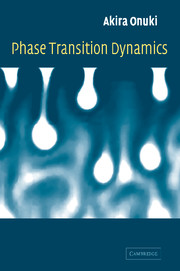1 - Spin systems and fluids
Published online by Cambridge University Press: 13 August 2009
Summary
To study equilibrium statistical physics, we will start with Ising spin systems (here-after referred to as Ising systems), because they serve as important reference systems in understanding various phase transitions [1]–[7]. We will then proceed to one- and two-component fluids with short-range interaction, which are believed to be isomorphic to Ising systems with respect to static critical behavior. We will treat equilibrium averages of physical quantities such as the spin, number, and energy density and then show that thermodynamic derivatives can be expressed in terms of fluctuation variances of some density variables. Simple examples are the magnetic susceptibility in Ising systems and the isothermal compressibility in one-component fluids expressed in terms of the correlation function of the spin and density, respectively. More complex examples are the constant-volume specific heat and the adiabatic compressibility in one- and two-component fluids. For our purposes, as far as the thermodynamics is concerned, we need equal-time correlations only in the long-wavelength limit. These relations have not been adequately discussed in textbooks, and must be developed here to help us to correctly interpret various experiments of thermodynamic derivatives. They will also be used in dynamic theories in this book. We briefly summarize equilibrium thermodynamics in the light of these equilibrium relations for Ising spin systems in Section 1.1, for one-component fluids in Section 1.2, and for binary fluid mixtures in Section 1.3.
Spin models
Ising hamiltonian
Let each lattice point of a crystal lattice have two microscopic states.
- Type
- Chapter
- Information
- Phase Transition Dynamics , pp. 3 - 33Publisher: Cambridge University PressPrint publication year: 2002

